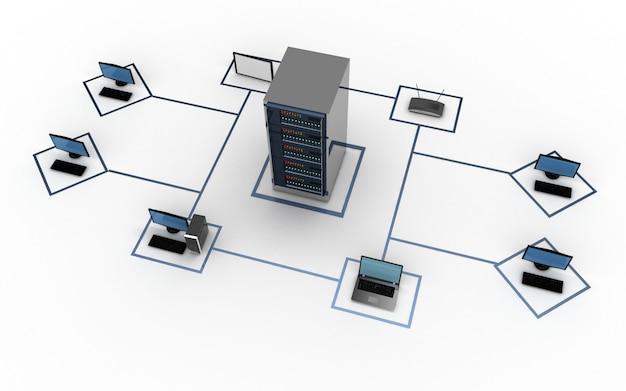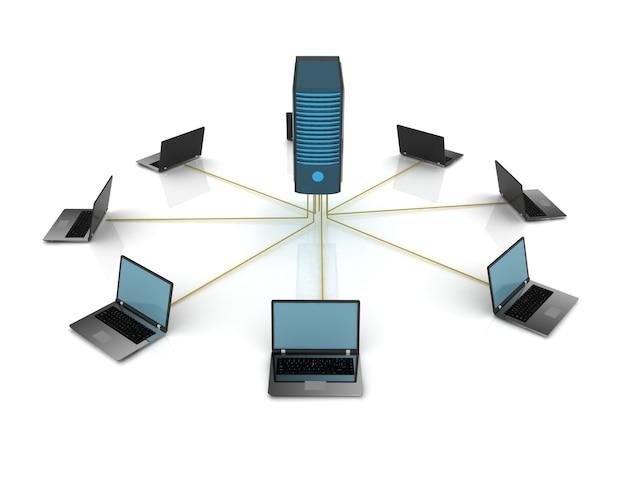The world of networking can sometimes seem like a maze of terms and devices, but fear not! In this blog post, we’ll unravel the mystery behind a star topology and explore the essential networking equipment that holds it all together. Whether you’re a tech enthusiast or a casual user looking to understand the basics of network setups, this post will provide you with the answers you need.
But first, you might be wondering, what exactly is a star topology? In simple terms, a star topology is a network configuration where all devices are connected to a central point. It gets its name from the visual representation of devices branching out from a central node, much like the rays of a star. Now, let’s dive deeper into the heart of this configuration to discover the key networking equipment that resides at its center.
So grab your favorite beverage, get comfortable, and let’s unravel the secrets of star topologies and the essential equipment that powers them!
What Networking Equipment is Usually at the Center of a Star Topology
The star topology, often used in computer networks, revolves around a central figure that keeps everything running smoothly. Just like the sun in our solar system, the central networking equipment in a star topology holds immense power and importance. Let’s take a closer look at the unsung hero at the heart of this connectivity cosmos.
The Almighty Switch: Ruling the Network Universe
At the core of a star topology sits the mighty switch. This networking device, resembling a power strip on steroids, is the command center for all the interconnected devices. Think of it as the traffic cop, controlling the flow of data with authority and finesse.
Unlike a power-hungry dictator, the switch is a benevolent force, allowing various devices to communicate efficiently. It connects computers, printers, and other gadgets with the finesse of a master puppeteer, ensuring they work in harmony to fulfill our desires.
The Switch: Connecting the Dots
With its multiple ports, the switch acts as a hub of connectivity, creating a central meeting point for all devices in the network. It connects everything from laptops to smart refrigerators, allowing them to share information and dance to the same technological beat.
But wait! Don’t confuse the switch with a certain light-switch on your wall. While both control the flow of something important, one manages the flow of data, while the other manages the flow of light (unless you’re living in some futuristic, Illuminati-controlled home).
The Radiant Router: Guiding Data Where it Needs to Be
While the switch might be the star of the show, the router plays a crucial supporting role in a star topology network. This celestial device helps guide data packets along their cosmic journey, ensuring they reach their intended destinations with unrivaled precision.
The Router: Not a Lost Tour Guide
Don’t worry; this router isn’t the kind of tour guide who gets lost every five seconds, leaving you stranded in unfamiliar territory. The networking router is more like a GPS, navigating the vast digital landscape and directing data packets through the complex maze of cyberspace.
With its innate intelligence and ability to make split-second decisions, the router ensures that your precious packets of data find their way home, even if the Internet is as confusing as the theory of relativity.
A Match Made in Technological Heaven
The star topology’s power couple, the switch, and the router, work side by side like Batman and Robin, Sherlock Holmes and Dr. Watson, or mac and cheese. They’re a dynamic duo, ensuring smooth sailing for devices connected to the network.
When the switch and router join forces, they create a well-structured network where devices can communicate without a hitch. It’s like having a team of synchronized swimmers performing an intricate routine, all coordinated by the command center at the heart of the star topology.
In the dazzling world of a star topology network, the switch and router form an unbreakable bond, enabling connectivity and keeping the digital ecosystem functioning smoothly. From controlling data flow to guiding packets through the vast expanse of cyberspace, these networking superheroes ensure our devices stay connected and our data reaches its intended destinations. So, next time you marvel at the wonders of your network, give a nod of appreciation to the unsung stars at its very center—the switch and the router.
Frequently Asked Questions about Networking Equipment in a Star Topology
Which is Better: Mesh or Extender
Choosing between a mesh network and an extender depends on your specific needs. Mesh networks are typically better for larger areas or multi-story homes, as they provide seamless coverage without any dead zones. On the other hand, extenders can be useful for smaller spaces where coverage may not be a major concern. Ultimately, it’s best to evaluate your requirements and consider factors such as range, interference, and ease of setup before making a decision.
What is the Central Device in Star Topology
In a star topology, the central device is usually the central hub or switch. This device acts as the central point of connection for all other devices within the network. It efficiently manages the flow of data by receiving and forwarding it to the appropriate devices, ensuring smooth communication between all connected devices.
Is There an App to Control WiFi Users
Yes, there are several apps available to help you monitor and control the users on your WiFi network. These apps provide features like device management, setting usage limits, and even blocking unauthorized users. Some popular options include WiFi Analyzer, Fing, and NetSpot. These apps can give you better control over your network and ensure efficient usage of your WiFi resources.
How Do I Know if My Access Point is Working
To determine if your access point is working, you can perform a few simple checks. First, ensure that it is powered on and connected to your network properly. Then, try accessing the internet through devices connected to the access point. If the devices can successfully connect to the internet and access websites or other online services, it indicates that your access point is functioning correctly.
Is Mesh Better Than Access Point
The choice between a mesh network and an access point depends on your specific requirements. Mesh networks excel in providing seamless coverage over larger areas and are great for eliminating dead spots. Access points, on the other hand, are ideal for extending coverage in wired networks or larger organizations. Ultimately, it’s best to evaluate your needs and consider factors such as coverage area, scalability, and budget to determine whether a mesh network or access point is more suitable for you.
How Do I Find Out What the Unknown Device is on My WiFi
If you encounter an unknown device on your WiFi network, you can find its identity by using a variety of methods. One option is to check the MAC address, a unique identifier for each device connected to a network. Lookup services like MAC Address Lookup or Wireshark can help you identify the manufacturer of the device based on its MAC address. Another option is to disable the unknown device temporarily and observe any changes in your network’s behavior to determine its purpose.
How Many Wireless Access Points Do I Need
The number of wireless access points you need depends on factors such as the size and layout of your space, the number of devices connected, and the desired coverage area. As a general rule, it’s recommended to install one access point for every 2,000 to 3,000 square feet in a typical office or home environment. However, it’s best to conduct a site survey or seek professional advice to determine the exact number of access points needed for optimal coverage and performance.
What Are Examples of Star Topology
Star topology is commonly used in various networking scenarios. Some examples include home networks, where the central hub or switch connects to devices such as computers, printers, and smart TVs. Additionally, star topology can be found in office networks where a central switch connects to individual workstations or other network devices. The flexibility, ease of management, and efficient data flow make star topology a popular choice in many networking setups.
What Networking Equipment is Usually at the Center of a Star Topology
The central device at the heart of a star topology is typically a central hub or a switch. It serves as the focal point for all network connections, providing a centralized location for data exchange between devices in the network. The central hub or switch efficiently manages data transmission, directing information to the intended destinations within the network.
What Are the Advantages and Disadvantages of Star Topology
Star topology has several advantages that make it a popular choice. Firstly, it offers easy installation, as connecting devices to a central hub or switch is straightforward. Secondly, it provides better performance and faster data transfer rates since data only needs to travel between the central device and individual devices. However, a potential disadvantage is that star topology relies heavily on the central device, so a failure in the central hub or switch can disrupt the entire network. Additionally, it may require more cabling compared to other topologies like bus or ring.
What is Honhaipr
Apologies, but I couldn’t find any information about “Honhaipr.” It could be a term or acronym specific to a particular context or organization. If you have more information or context about “Honhaipr,” I would be happy to assist you further.
How Many Devices are Too Many for a Router
The number of devices that a router can handle depends on various factors, such as the router’s specifications, its processing power, and the activities of the connected devices. Most consumer-grade routers can handle a typical household’s network needs with around 20-30 devices. However, as the number of devices increases, the router’s performance may start to degrade. If you experience connectivity issues or slow internet speeds with a large number of devices, it might be worth considering adding additional networking equipment like access points or upgrading to a more robust router.
How Far Apart Should Access Points Be
The optimal distance between access points depends on factors such as the coverage area, building layout, and potential sources of interference. As a general guideline, placing access points around 50-70 feet apart can help ensure seamless coverage in typical residential or office environments. However, it’s crucial to perform a site survey to evaluate signal strength, signal overlap, and potential interference sources. This survey will give you the specific information needed to determine the ideal placement and spacing of access points for your network.
How Do I Find the MAC Address
To find the MAC address of a device, you can follow these general steps:
- For Windows:
- Open the Command Prompt by pressing Win + R, typing “cmd,” and pressing Enter.
- In the Command Prompt, type “ipconfig /all” and press Enter.
-
Scroll through the list of network adapters to find the MAC address corresponding to the desired device.
-
For macOS:
- Go to System Preferences and select Network.
- Choose the desired network interface on the left, then click the Advanced… button.
-
Navigate to the Hardware tab, where you will find the MAC address listed as the “Ethernet ID” or “Wi-Fi ID.”
-
For mobile devices:
- Access the Settings menu of your device.
- Look for the Wi-Fi or About section.
- You should find the MAC address listed as MAC Address, Wi-Fi Address, or Physical Address.
Remember, the location and terminology may vary slightly depending on your device and operating system.

